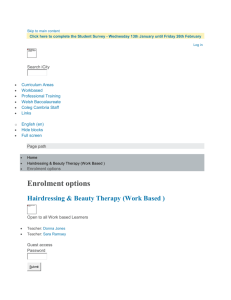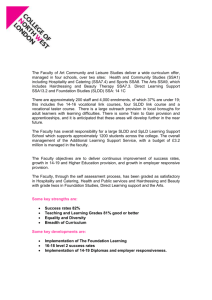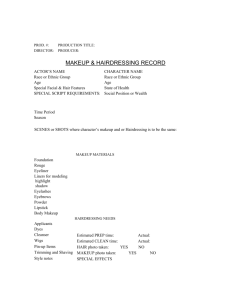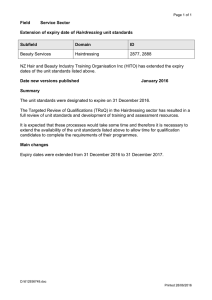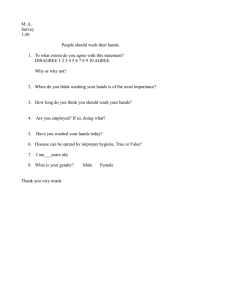guidelines for operators of hairdressing
advertisement
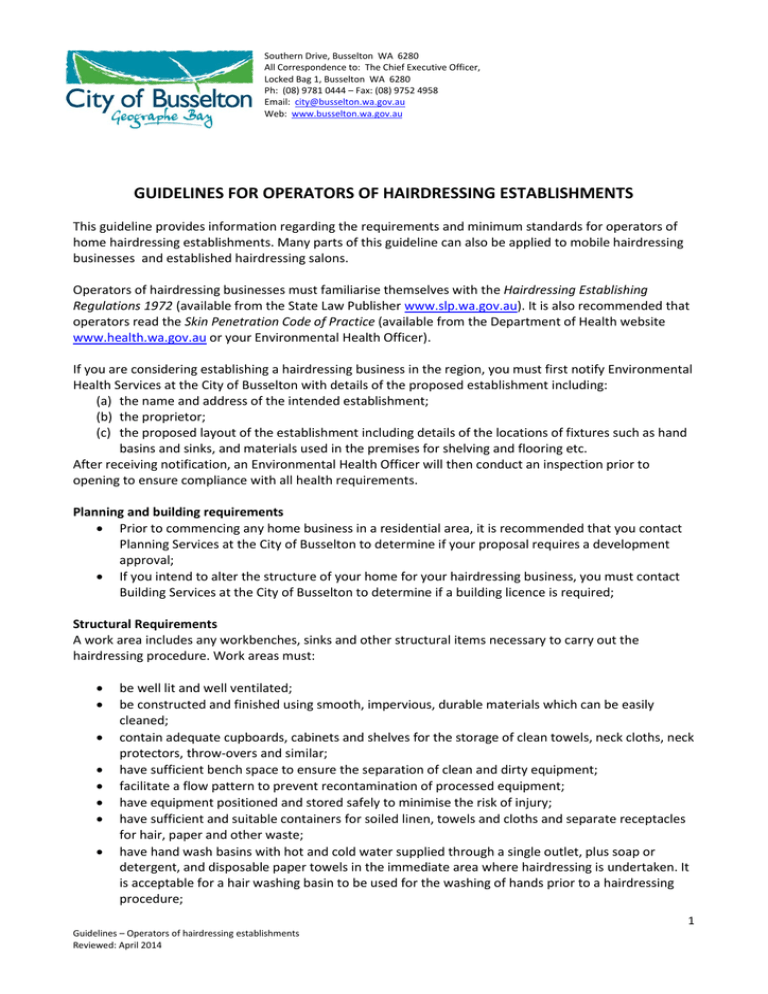
Southern Drive, Busselton WA 6280 All Correspondence to: The Chief Executive Officer, Locked Bag 1, Busselton WA 6280 Ph: (08) 9781 0444 – Fax: (08) 9752 4958 Email: city@busselton.wa.gov.au Web: www.busselton.wa.gov.au GUIDELINES FOR OPERATORS OF HAIRDRESSING ESTABLISHMENTS This guideline provides information regarding the requirements and minimum standards for operators of home hairdressing establishments. Many parts of this guideline can also be applied to mobile hairdressing businesses and established hairdressing salons. Operators of hairdressing businesses must familiarise themselves with the Hairdressing Establishing Regulations 1972 (available from the State Law Publisher www.slp.wa.gov.au). It is also recommended that operators read the Skin Penetration Code of Practice (available from the Department of Health website www.health.wa.gov.au or your Environmental Health Officer). If you are considering establishing a hairdressing business in the region, you must first notify Environmental Health Services at the City of Busselton with details of the proposed establishment including: (a) the name and address of the intended establishment; (b) the proprietor; (c) the proposed layout of the establishment including details of the locations of fixtures such as hand basins and sinks, and materials used in the premises for shelving and flooring etc. After receiving notification, an Environmental Health Officer will then conduct an inspection prior to opening to ensure compliance with all health requirements. Planning and building requirements Prior to commencing any home business in a residential area, it is recommended that you contact Planning Services at the City of Busselton to determine if your proposal requires a development approval; If you intend to alter the structure of your home for your hairdressing business, you must contact Building Services at the City of Busselton to determine if a building licence is required; Structural Requirements A work area includes any workbenches, sinks and other structural items necessary to carry out the hairdressing procedure. Work areas must: be well lit and well ventilated; be constructed and finished using smooth, impervious, durable materials which can be easily cleaned; contain adequate cupboards, cabinets and shelves for the storage of clean towels, neck cloths, neck protectors, throw-overs and similar; have sufficient bench space to ensure the separation of clean and dirty equipment; facilitate a flow pattern to prevent recontamination of processed equipment; have equipment positioned and stored safely to minimise the risk of injury; have sufficient and suitable containers for soiled linen, towels and cloths and separate receptacles for hair, paper and other waste; have hand wash basins with hot and cold water supplied through a single outlet, plus soap or detergent, and disposable paper towels in the immediate area where hairdressing is undertaken. It is acceptable for a hair washing basin to be used for the washing of hands prior to a hairdressing procedure; 1 Guidelines – Operators of hairdressing establishments Reviewed: April 2014 have hair washing basins provided for every 3 work stations. Hairdressing implements that have not been exposed to blood can be washed in a hair washing basin. It is not suitable to use a hair washing basing for the washing of hands following exposure to blood or body fluids, or to wash crockery. A basin should always be available for washing hands. not be used for any other purpose. A substantial wall must separate any other activity within the premises; have a floor of smooth, impervious and washable finishes. Tiled or linoleum floors are desirable; ensure that if refreshments are served to customers, the refreshments are to be prepared in a completely separate room from the hairdressing section. Health Requirements and the risk of infection Infection can occur during hairdressing procedures. Items such as razors, combs, clippers and hairpins can accidentally penetrate the skin. Blood and body fluids do not have to be visible on instruments, equipment or working surfaces for infection to be transmitted. Both clients and operators may be at risk. Infections that can be spread in hairdressing premises include skin infections on the scalp, face and neck such as impetigo (also known as school sores) and fungal infections such as tinea capitis and ringworm. These infections can spread when instruments and equipment used on clients are not cleaned between client’s sessions or are not handled or used in a hygienic manner, and when structural facilities such as furnishing sand fittings are not kept clean and in good repair. Cleaning and Sterilisation of Hairdressing Equipment The use of disinfection products requires operators to apply these solutions in strict accordance with the manufacturer’s directions. The table below provides a guide on cleaning requirements for equipment commonly used in the hairdressing industry. Equipment Single-use razors Safety razors Haircutting razors Cut throat razors with single-use blade only Electric razors Shaving brushes Electric clippers Electric haircutting razors When How Potential for skin infections or bloodborne virus transmission Potential for skin infections or bloodborne virus transmission After each client Dispose of into a sharps container After each client Dispose of blade into a sharps container. Wash handle in warm water & detergent. Rinse in hot running water. Dry with lint-free cloth. If contaminated sterilise or dispose of into a sharps container Potential for skin infections or bloodborne virus transmission Potential for infection if previous client has facial skin lesions or infection Potential for skin infections or bloodborne virus transmission Do not use Potential for infection or infestation After each client After each client After each client Rinse free of hair and shaving cream. Wash in warm water and detergent. Rinse in hot running water. Dry thoroughly Use lint-free cloth to remove hair. Wipe clipper blade attachment with alcohol. Wipe over body of clipper with a damp cloth containing detergent and water or alcohol. Dry with lint-free cloth Dispose of blades into sharps container. Wipe over razor body with a damp cloth containing detergent and 2 Guidelines – Operators of hairdressing establishments Reviewed: April 2014 Scissors Combs Hair brushes, Hairnets Ear caps Hair pins/clips Rollers – regular and hot Hot tongs Crimping tongs Dye mixing bowls water or alcohol Wash in warm water and detergent. Rinse in hot running water. Dry with lint free cloth Potential for blood borne virus transmission or infestation Potential for infection or infestation After each client After each client and when dropped on the floor Use lint-free cloth to remove hair. Wash in warm water and detergent. Rinse in hot running water. Dry with lint-free cloth Potential for infection or infestation After each client and when dropped on the floor When empty Use lint-free cloth to remove hair. Wash in warm water and detergent. Rinse in hot running water. Dry with lint-free cloth Wash in warm water and detergent. Rinse in hot running water. Dry with lint-free cloth Wash in warm water and detergent. Rinse in hot running water. Dry with lint-free cloth Potential for contamination Shaving bowls Potential for contamination After each client Capes/Wraps Potential for infection if previous client has neck skin lesions or infection Equipment Trolley Prevention of dust and hairs from accumulating or contaminating clean equipment After each client unless a clean towel or paper tape is used around the neck At least weekly Wash in warm water and detergent. Rinse in hot running water. Dry according to type of material Use lint-free cloth to remove hair. Wash in warm water and detergent. Dry thoroughly with lint-free cloth before refilling Hand washing Hand washing is the most important and most basic technique in preventing the spread of infection. Hairdressers must wash their hands: • Before and after contact with each client; • Before resuming a procedure if interrupted, for example, answering the telephone; • Immediately prior to putting on new disposable gloves; • Immediately after removing disposable gloves for any reason; • After handling the nose, mouth or handling a nasal tissue or handkerchief; • Before and after smoking, eating or drinking; • After going to the toilet; and • After contact with blood or other bodily fluids (of self or other person). Can hairdressers use cut throat razors? Cut throat razors with a non-changeable blade are not permitted for use in any commercial hairdressing establishment due to the risk of spreading blood borne viruses from one client to another. Where cut throat razors are used, the blade must be single use and disposed of into a sharps container after using on each client. This is a guideline only. There are special requirements for beauty therapy, waxing, or any other procedure where there is a risk of breaking the skin. For more information please contact Environmental Health Services at the City of Busselton on 9781 0444. 3 Guidelines – Operators of hairdressing establishments Reviewed: April 2014
